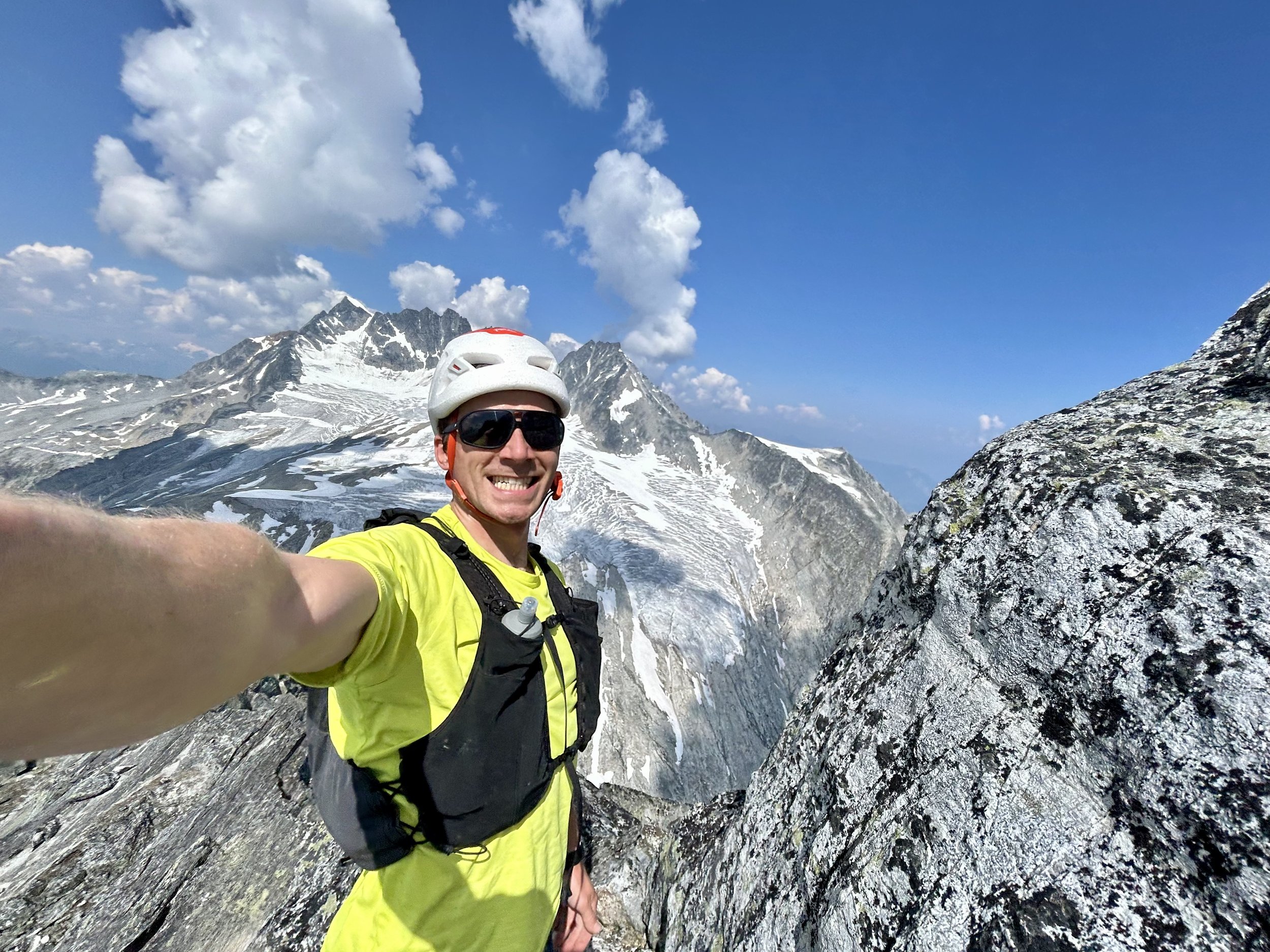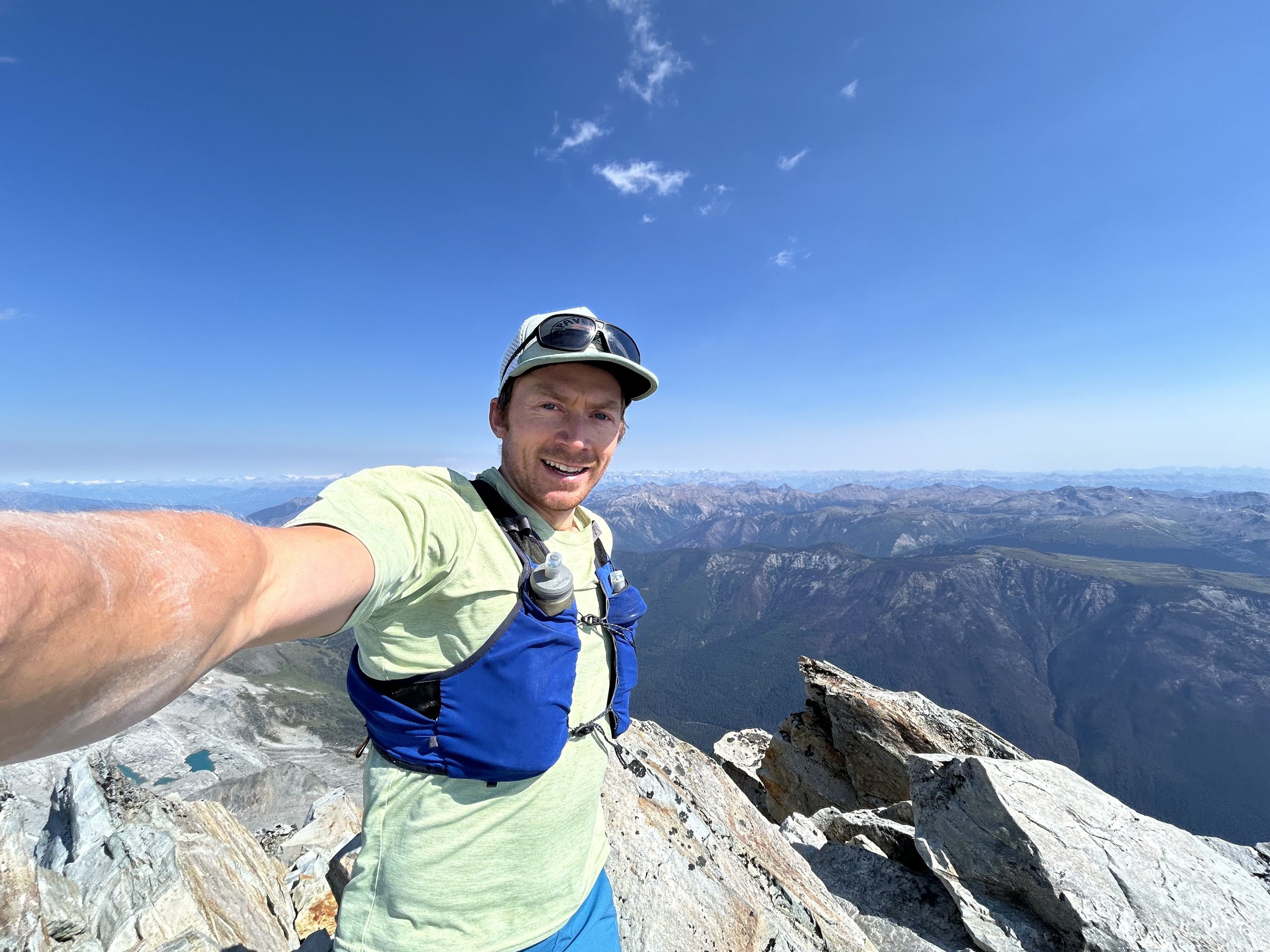Summer 24 - Sir Donald
It's early October here in the Rockies. Snow blankets the high mountains, creating a striking contrast—dark green spruce and pine trees against the brilliant yellows and burnt oranges scattered across the valley floor.
Seasons changing in the Bow Valley
It’s no surprise, but once again, this brief period in the Rockies where the alpine is warm(ish) and generally free of snow has come and gone. My summer had relatively little in the way of ‘success,’ as for one reason or another, I kept coming up just short of a few objectives I was keen on this year. Objectives with a well-defined endpoint—such as a summit, an anchor to clip, or a time to beat—are interesting because when we fall short, it can be considered a failure, and naturally, another effort seems necessary before considering an objective ticked off. Personally, I don’t think this mindset is so bad, as aiming at objectives or goals that may not be achievable often brings about greater experiences.
This summer for me was more or less made up of numerous efforts that never quite worked out as I had hoped. One of these was a speed climb of the NW Ridge of Sir Donald.
NW Ridge of Sir Donald
This is perhaps one of the finest ridge climbs, with approximately 700 meters of remarkably good quartzite leading directly to the summit. The climbing is quite easy along this route, consisting mostly of 4th class and some low 5th class sections. What makes it unique is the sustained and exposed nature of the route. Due to both the excellent trail leading up to the base of the ridge and the quality of the rock, this route is ideal for pushing the standard of moving fast from car to summit and back. All said, the route ascends about 2000 meters in vertical gain from the trail head.
The NW Ridge of Sir Donald
The first real speed lap of this route that I’m aware of was likely done by Sean O’Rourke back in 2017, with a round-trip time of 4 hours and 37 minutes. If you know of Sean, you know that he is certainly no slouch when it comes to moving fast in the mountains. In 2020, Michael Burke improved this time by 11 minutes. A few years later, Michael was back and put down a remarkably fast time of 3 hours and 51 minutes.
Having climbed the route about a dozen times leading up to this summer, and having an affinity for speed in the right circumstances, this route caught my interest as an interesting goal to work on. Contrary to popular belief, speed climbing does not simply mean taking more risks in exchange for speed or leaping from rock to rock. The reality of pushing times on these routes means dialing in the movement and scrambling/climbing as optimally and efficiently as possible. This typically means that when it comes time to do a speed effort, you are incredibly focused and glued onto the rock, climbing it perfectly. Of course, fitness is also a huge part of these efforts—if you don’t have the legs, you might as well not even bother.
My main objective for the NW Ridge this summer was to try and go sub-4 hours, but I also had in mind that improving on the 3-hour and 51-minute time would be nice and likely possible if my fitness and execution were perfect. Initially, I was keen to make a trip to the route in June, as there tends to be less traffic that time of year and the days are long. However, due to a prolonged minimum group-of-four trail restriction (due to grizzly bears), I didn’t end up getting on the route until early July.
Selfie near the summit of Tupper
My first attempt on the route felt like it was over before it even started. I settled into a nice groove after the first 20 minutes and was feeling excellent, well-rested after a taper the week prior. As I started up a steep section of the trail after the first creek crossing, I heard a rustling in the bushes ahead, followed shortly by a large grizzly standing above me with a few cubs by her side. Needless to say, I made a prompt retreat back down the trail. Feeling both relieved and disappointed at the same time, I decided to salvage the day by heading over to Mt. Tupper. With some gas still in the tank, I ended up doing a round-trip time on Tupper in 3 hours and 20 minutes, which also turned out to be the FKT.
Summit of Sir D.
A week or so later, I had the opportunity and the good weather to make another attempt on Sir Donald. This effort was a real bust, thanks to my experimentation with sodium bicarbonate (i.e., baking soda). I won’t go into detail here, but suffice to say there are some notable ergogenic benefits to supplementing with sodium bicarb before hard efforts, and for some reason, I thought I’d test out the Maurten bicarb product for this attempt. This turned out to be a big mistake, as it caused some of the worst stomach cramps I’ve ever experienced. Not wanting to lose a spectacular day in the pass, I decided to do the NW Ridge regardless—albeit at a much slower pace.
Yet another selfie
Round three came a few weeks later. At this point, I was starting to feel a bit over Sir Donald for the summer, as a few trips to the pass are usually enough for me. But not having given it a solid effort yet this year, I felt motivated enough to make the journey one more time. Overall, this attempt went very well, and despite some heavy legs from a full week of activity leading up to it, I still managed to reach the summit in 2 hours and 20 minutes. Feeling great at the summit, I decided to put in a good effort on the descent. I ended up taking the bypass instead of downclimbing the ridge to avoid a few parties that were still making their way up. The descent down the ridge went smoothly, and I was having a very enjoyable time. However, once I reached the col, things started to go awry.
First off, I rolled my ankle on a relatively benign section of trail (just typical), which caused some serious pain and forced me to hobble for about 10 minutes. Fortunately, no real harm was done, and I was back to running down the trail at a good pace. The next major hiccup was trying to relocate a bear spray I had stashed behind some rocks at the tree line. For the life of me, I couldn’t find it, and after about 5 minutes of searching, I gave up and decided I’d come back later to retrieve it. Back to blitzing down the trail, I came across a group of hikers standing at the junction to Perley Rock. They informed me that a grizzly with cubs (which turned out to be the same one as before) was parked on the trail about 50 feet ahead, and they were headed in the opposite direction.
Now I had a dilemma. Do I proceed and go for it, hoping to achieve FKT fame (I say this tongue-in-cheek), or do I turn back, re-ascend the trail to retrieve my bear spray, and wait for my partner, who was doing her own outing on the SW Ridge of Uto? If you do have to make a close acquaintance with a grizzly, it’s advisable to do so with a group (or at least not solo) and bear spray in hand. Having had close encounters with these impressive creatures more times than I’d like, I’m happy to give them space. So, back up the trail I went, turning this outing from an FKT effort into just another good day of getting in my vertical.
I had considered giving the route another go, but I was more interested in other objectives at this point and was happy to move on for the year.
The elusive bear spray
A Note About the Gear
Notably for Sir Donald, you don’t need much. Typically, I’d bring a very light bag like a Patagonia Slope Runner to carry a Houdini jacket, gloves, space blanket, snacks, liquids, bear spray, and a Zoleo. I do think a waist belt would be better, but I have yet to find the perfect one to comfortably fit my kit when it’s more than just a soft flask and a jacket. I used poles a few times on the ascent up to the col, which I found useful. There are a few good spots to fill up bottles, so two 500ml soft flasks are more than adequate.
Footwear can be a tough decision for objectives like this, where it’s not just about weight. For my first few efforts this year, I opted to use the Scarpa Rapids as they run quite nicely but also climb reasonably well. However, for my last effort this summer, I decided to go with the newer Gecko LTs. Despite being heavier than the Rapids and having relatively poor running abilities, the incredibly sticky rubber and overall climbing performance of this shoe turned out to be well worth the trade-off. They were even remarkably comfortable and nimble for charging back down the steep trails. Although the climbing is relatively easy and blocky, the more security and confidence you have in your feet, the faster you will move.





